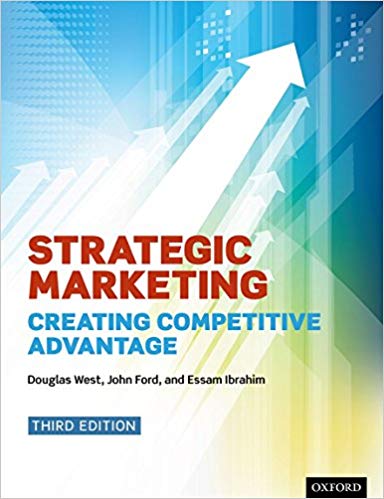We are delighted to have Professor Doug West of Kings College London as a guest contributor to the UP blog this month. This article is summary of the class Professor West teaches on his course on Marketing Strategy & Planning.

Marketing Strategy & Planning
Competitive marketing strategy is ‘a market-oriented approach that establishes a profitable competitive position for the firm against all forces that determine industry competition by continuously creating and developing a sustainable competitive advantage (SCA) from the potential sources that exist in a firm’s value chain.’
The key elements are:
- Market-oriented: the strategy is based upon the needs and wants of the marketplace. Given that marketplace is often global, companies need to consider international expansion and acquisition strategies (Yip, Rugman and Kudina, 2006) as well.
- Establishes a profitable market position: the end goal of the strategy is to make a profit in the for-profit sector or to meet alternate metrics such as in the not-for-profit sector. In the latter case for example, a road safety campaign based on a particular marketing strategy might ‘make a profit’ if there is a decline in road injuries and deaths attributed to it.
- Forces that determine industry competition: these are all the complex mix of ingredients that create the marketing ‘whirlwind,’ such as government regulation, global competition or the extent of buyers knowledge and understanding of a particular market.
- Continuously creating and SCA: marketing strategy is not about one-off transactions. The aim is to reach a point where an organisation finds a place in the market that fits its available marketing resources. Few (if any) organisations can just rest on their laurels, so the idea is find a spot where, if need be, the primary challenges can be tackled. Not all organisations have to do this on a continuous basis of course, but if they had to, an organisation with a sound competitive marketing strategy would be able to. A simple example: you might make the best tomato ketchup in the best-recognised glass bottles, but if the market moves towards plastic ‘squeezy’ bottles you need be able to adapt.
- Potential sources that exist in a firm’s value chain: competitive marketing strategy relates to what value any organisation wants to create using its available marketing resources.
THINKING FIRST
The module takes rational ‘Thinking First’ as the basis for marketing strategy, which is an approach that is primarily logical, sequential and linear. Thinking First is about analysing a strategic marketing problem and developing the solution (the strategy) through a carefully thought-through and largely sequential process. Instant views and decisions are not made, though it can help to occasionally see the ‘big picture.’ It can involve some inspiration and insight, but largely the process is one of painstakingly doing your homework to arrive at a solution.
Thinking First is closely connected to a market-driven approach, such as Tesco’s and BMW which stand apart by their devotion to customer value and their culture, process and abilities. Volvo is generally is an example of a company at the forefront of customer satisfaction practices (Dahisten, 2003) given their policy that “Customer satisfaction is the way we measure quality.” Recognising the need for a greater extrinsic focus to provide greater customer satisfaction insight, Volvo has added a more proactive approach to its research. Principally, qualitative has been added to the mix with much greater direct customer contact involving engineering teams, senior managers and dealers. Interactions with customers on the web and through local workshops in different markets are being made so that customers shifting perceptions of issues, such as on safety, are being more strongly tracked. Lost-sales analyses have been instigated to capture the perceptions of customers who decided not to buy Volvo.
SEEING FIRST
Seeing First reminds us that the importance of seeing the overall decision is sometimes greater than thinking about individual elements. As Mozart noted—the best part of creating a symphony was to, "see the whole of it at a singleglance in my mind"(Mintzberg and Westley, 2001). Seeing first is basically insight and insight often only comes after a period of preparation, incubation, illumination and verification in the cold light of day (Wallas, 1926). So the best way of seeing first might be after a process of rational analysis. The 'eureka' moment has been often known to come after sleep, as rational thought is generally switched off during sleep. Thus, Seeing First is cognitive process but it relates to the whole picture rather than a sequential analysis.
‘Seeing First’ has most relevance with new ventures or dramatic changes of direction. The reality with Seeing First is that, invariably, you need to do your homework. That is you also need to be able to think first. Mozart may have been able to See First before he wrote his symphonies, but the application of this to marketing strategy is less obvious. You might occasionally have luck with seeing first, but for the most part marketers need to examine the trends and the evidence and be able to develop some sense of what is important within the mass of actions and events. A more accessible alternative approach is to see the ‘Big Picture’ which does involve thinking first. Successful marketing strategy requires the ability to move from tactical detail to a ‘Big Picture’ overview of the market to place their strategy in context.
DOING FIRST
When you cannot think it through and you do not see it, what do you do? 'Doing first' is when marketing managers experiment and learn from their mistakes and successes. The process is: (1) do something, (2) make sense of it and (3) repeat the successful parts and discard the rest. Instead of marketing strategy, the reality is often that ‘doing’ drives. For example, many companies that have successfully diversified their businesses have done so by a process of figuring out what worked and what did not.
‘Doing First’ is a credible and viable strategic approach. There are often circumstances and issues that are virtually impossible to disentangle and coordinate the best course of action. Doing First enables organisations to try out marketing strategies and with careful monitoring, assess the results. It provides a way to test the boundaries of stretching a brand, the viability of new kinds of distribution channel and so on and so on. However, Thinking First is still a necessity in establishing how you will define and measure the success of any Doing First strategy.
SIMPLE RULES
Marketing strategy as simple rules is about selecting a few key marketing strategic processes, crafting a handful of simple rules and ‘jumping in’ rather than avoiding uncertainty. In many respects the approach is related to ‘doing first’ except that the rules are predefined. Companies like Vodafone and Yahoo! have excelled without the traditional advantages of superior resources or strategic positions. According to Eisenhardt and Sull (2001) the key to their success has been the use of simple rules:
‘Simple Rules’ is an approach particularly well-suited to complex markets. How do you identify the Simple Rules to use? You need to Think First and establish your business model and propositions. Once you have done this you can identify, establish and put your simple marketing strategy rules into place. To do this the much-neglected Thinking First art of scenarios can be utilised. Scenarios are often misunderstood as part of competitive marketing strategy, but can aid a Simple Rules marketing strategy.
POSTMODERN
A completely different view of strategy is provided by the postmodern school. Underpinning the approach of postmodern marketing strategy is the proposition that buyers are increasingly sophisticated and cynical about ‘regular’ marketing.
Wright (1985) has argued that consumers have to interpret and withstand marketer’s sales appeals and that they develop knowledge and coping tactics to do so. ‘Persuasion knowledge’ helps consumers identify how, when, and why marketers try to influence them and helps them adapt and respond to persuasion attempts to achieve their own goals (Friestad and Wright, 1994). Developing this notion that consumers have developed ‘schemer schema’ or intuitive theories about marketers’ attempts to influence them, they draw marketers’ attention to ‘folk’ models of persuasion. These observe that consumers learn about persuasion in many ways: from every day social encounters, from observing marketers and other persuaders, and from media commentary on marketing and advertising tactics.
One of the leading proponents of the postmodern view, Stephen Brown (2001) argues that customer centric marketing has gone too far and now places many companies in the position of Uriah Heep: “unctuous, ubiquitous and unbearable.” His view is that people do not want the truth, the whole truth and nothing but the truth. They certainly do not expect truth from marketers. People want marketing to be about glitz, glamour and to be mischievous and mysterious. Marketing should be fun, but any nastiness is forbidden. Contemporary consumers find marketing’s obsession with love, honour and obey embarrassing so they would prefer a lovable rogue to the ‘Disneyfied’ version that is the norm of today. Retromarketing harks back to the ‘good old bad days’ when marketers were pranksters and proud of it.
APPROACH
Considering marketing strategy overall, the key issue is to recognise what approach is appropriate. Both Thinking First and Seeing First are largely cognitive whereas Doing First and Simple Rules are largely experiential in nature. On the other hand both Doing First and Thinking First are largely ongoing and formative whereas Simple Rules and Seeing First are largely immediate in their application. ‘Largely’ is the key word here as there are elements of experience, cognition, immediacy and longer-time scales in all four approaches.
Thinking First/Market Orientation works best when the issues are clear, the data are reliable, the context is structured, thoughts can be pinned down and discipline can be applied. On the other hand, Seeing First works best when many elements have to be creatively applied, commitment to solutions is key and communications across boundaries are needed (e.g. in NPD). Doing First or simple rules work best when the situation is novel and confusing, complicated specifications would get in the way and a few simple relationship rules can help move the process forward.
Throughout, the Postmodern orientation needs to be continually borne in mind to provide a check on how, in reality, buyers will interpret the final offering but the module essentially takes a ‘Thinking First’ view of competitive marketing strategy from a market-driven perspective. Thus, it nods more towards the Igor Ansoff (1991) synoptic and deliberate approach to strategy than the more incremental and emergent approach advocated by Henry Mintzberg (1990).
CONCLUSION
Developing a marketing strategy is a largely subjective activity. This module suggests that Thinking First is the best model to adopt given a rational and linear thinking perspective. Marketers appreciate that there are constraints on our ability to make optimal choices. All decision-making is in a state of ‘bounded rationality’ owing to complexity, limited time and inadequate mental computational power (Buchanan and O’Connell, 2006). Strategy has been shown to be a fundamental component of business success along with execution, culture and structure. Things can go badly wrong such as with poor vertical communications or conflicting priorities and they often do.
Professor Doug West
Professor Doug West, Kings College London
Professor of Marketing
Head of Marketing Subject Group
Director MSc International Marketing
Visiting Fellow of Kellogg College, University of Oxford.
Professor West's book Strategic Marketing: Creating Competitive Advantage is one of the leading books on the subject in the UK and is available on Amazon.co.uk

